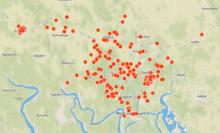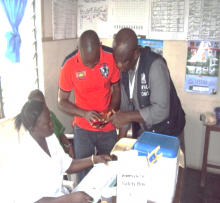Rivers State expands mobile technology for real-time disease surveillance reporting
Abuja, 10 March 2015 - In Rivers, one of the two States in Nigeria that recorded an outbreak of Ebola virus disease (EVD) and successfully contained it in August 2014, the World Health Organization (WHO) team is using the open data kit platform at the Ebola Emergency Operation Center’s server for enhanced acute flaccid paralysis (AFP) surveillance for polio as well as integrated disease surveillance and response (IDSR) reporting.
During the EVD outbreak, innovative technology such as form hub was used for real time contact tracing and case/laboratory monitoring; Geographic Information Systems (GIS) for mapping the location of cases; DateStamp (Date/time of data collection), pictures, contacts and as essential health facilities. An alert system was also developed in order to flag contacts that developed high temperature and other symptoms of the disease. In addition, a web dashboard was developed using python programming language to also view real time data for monitoring of all contacts.
Mr Godwin Akpan the WHO zonal data manager explained that “upon completion of each active case search using the phones, the data is automatically uploaded into a server and is available for action by stakeholders on a real-time basis”. The advantage of this is that data from the disease surveillance and notification officer (DSNOs) is available for all lines of reporting immediately the submission is made and with high level of accountability.
The technology requires each DSNO and the assistant DSNO in all 23 LGAs of the State to report findings during their separate weekly active case search to 10 HFs and send data via mobile phones.
According to the Rivers State Epidemiologist, Dr Nwadiuto Ifeoma, "the use of mobile technology for disease surveillance has proven to be effective in getting real time data for timely intervention. It has enhanced the existing surveillance system through immediate notification of diseases and minimized the falsification of data".
With the mobile technology, data on the server can be viewed simultaneously by both the WHO personnel and the State Ministry of Health (SMOH) officials to support and monitor DSNOs activities on the field without any paper work. Where there are gaps, appropriate actions are immediately instituted.
Dr Sylvester Maleghemi, the WHO Rivers State coordinator observed that the process makes it possible for every report of AFP/epidemic prone disease sent to the server, be verified and appropriately investigated on time. The average distances covered by each DSNO are equally captured on the server and reports are correctly validated for each location visited.
"This approach eliminates wrong reporting and effectively corroborates submitted data with electronically reported real time data. Consequently, this has improved IDSR timeliness and completeness reporting," the Dr Maleghemi added.
At the onset of the use of mobile technology for AFP and IDSR in October 2014, only 72% of the LGAs were meeting both AFP surveillance indicators but this improved to 87% by end of the year 2014. For 2015, Rivers State had reported 25 AFPs between January and February compared to 14 AFPs reported for the same time last year, representing a 79% increase in reporting. Additionally, all the cases are tagged with geo-coordinates which ensure more accurate mapping, tracking and verification.
Upon full operationalization, WHO will support capacity building and provide logistics support to reinforce use of the mobile devices to promote early reporting and timely investigation of all cases. Already, the Rivers State Hospital Management Board is looking at ways of scaling up the use of mobile devices for other public health interventions.
01 02 03
01. Distribution of health facilities visited by DSNOs in February 2015
02. Average distance covered by DSNOs based on GIS mapping for enhanced surveillance
03. WHO staff assisting a DSNO on mobile data collection
___________________________________________________
For more information, please contact:
Technical contacts:
Dr Pascal Mkanda; Tel: +234 803 402 2140; Email: mkandap [at] who.int (mkandap[at]who[dot]int)
Dr William Komakech; Tel: +234 803 960 6377; Email: komakechw [at] who.int (komakechw[at]who[dot]int)
Media contact:
Ms Charity Warigon; Tel: +234 810 221 0093; Email: warigonc [at] who.int (warigonc[at]who[dot]int)






